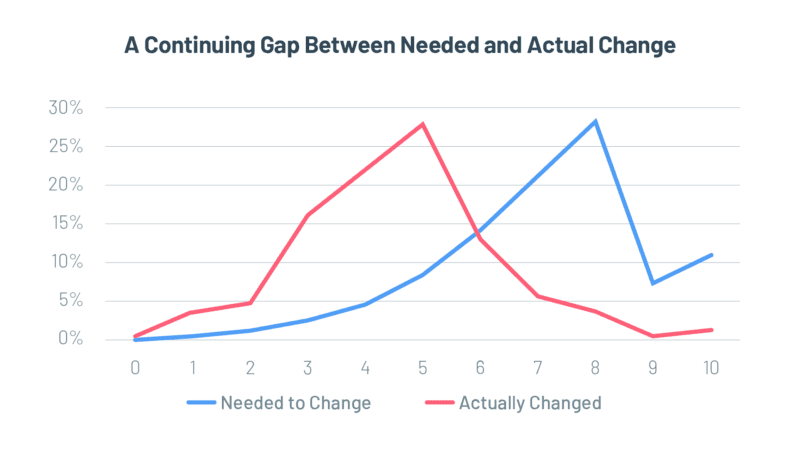The legal industry’s been abuzz about the importance of technological transformation since the last economic downturn in 2008. Firms understand they still have a long way to go; according to the findings from the Altman Weil Law Firms in Transition 2020 flash survey, law firm leaders unquestionably recognize the need for technological advancement. Unfortunately, actual advancement is lagging perceived need, as depicted in the chart created by Prism Legal’s Ron Friedmann:

Source: Prism Legal, “Large Law Firm Trends in 2020 — Part 1,” June 2020.
Channeling the Catalyst to Close the Gap
In contrast to what’s happening in the legal industry, the accounting and consulting sectors have been quicker to hit the gas on bringing transformation strategies to fruition, especially as they pertain to shifting business models to reflect the evolution of the marketplace. In the grander scheme, professional services firms have been on the heels of transformation for many years, as they’ve witnessed it take flight first-hand in other industries.
COVID-19 has sparked a bonfire, spurring law firms to take positive steps toward closing the technology gap. Anecdotally, firms are widely embracing virtualization; they’re recognizing that they can, in fact, utilize a remote work force, contrary to previously held biases against remote work. Firms are also saving an average of 3.5% of revenue due to renegotiated leases, according to Altman Weil. With nearly 100% of firms implementing work-from-home protocols as of March 2020, technological advancement is in its infancy. Entrenching the change — within people, process, and data — will need to be the next mountain to move.
Unifying Behind Cultural and Technological Change
Although change typically manifests as an evolution, COVID-19 and its economic effects have catapulted firms into revolution mode virtually overnight, whether they liked it or not. And, whereas it used to be that firms had to cajole folks to get with the program, working remotely forced staff to adapt instantaneously.
It’s a particularly jarring transition for the legal industry generally, because, as John Alber articulated so well in a recent article on success in transformative legal technology projects, firms are accustomed to functioning as archipelagos. Calling out how partnerships operate as a loose federation of island fiefdoms, Alber goes on to suggest that — in order to drive impact and realize value of a large-scale initiative — firm leaders must recognize and accommodate the various interests across the firm and the impact they will have on each “island”. This analogy’s key learning lies in the realization that creating sustainable change requires rallying the “islands” to support firmwide technological transformations in the new virtual world.
Connecting the Processes and the People
Best practices in culture management reinforce not only the importance of honest conversations, but also the necessity for listening and observing across the entire organization. Lessons learned from the 2008 recession underscore the need for firms to continuously improve processes in ways that generate meaningful business impact.
In Alber’s archipelagos analogy, he attributes disconnected processes to a fiefdom mentality, where practice group protocols are guided by their own leadership. Altman Weil’s survey readout points out how this tendency— particularly during these unprecedented times — should be cause for big concern, because efficiency improvements are vitally important and will remain a solid trend. However, merely identifying the need doesn’t mean action has been taken. Nonetheless, connecting firmwide processes must go hand in hand with connecting its people — which can be assisted by various technological methods, including AI-supported workflows and the Lean Six Sigma method.
Implementing Technological Transformation
A 2018 McKinsey study reported that organizations that successfully transform their technology suite — improving performance and equipping the organization to sustain those improvements over time — deploy more technology than others, particularly with respect to cloud-based and mobile services. It’s no surprise that technologies that support collaboration and process optimization help companies achieve better outcomes. Alber’s analogy also applies here, as he describes the disparate systems currently in place as a result of individual “island fiefdoms” going rogue and implementing solutions specific to their needs. When groups localize and hoard their data stream, it hinders the firm’s ability to connect and channel its full power behind technological transformation — which ultimately becomes a significant competitive disadvantage.
It’s clear that technological transformation is a critical driver of long-term success, and the success of the transformation hinges on a strong mandate to change the business model to support bringing the “island fiefdoms” together. As stated in McKinsey’s report, it’s about having the right leadership in place to drive the construction of capabilities needed to support the workforce of the future. This includes not only upgrading technology but also supporting staff through the transition toward working and communicating in entirely different ways — which, in turn, requires connecting people through process and data.
The COVID-19 pandemic has shined a spotlight on the peril of stagnation around connecting people through process and data. For firms that are still lagging on the initiatives required to achieve this connection, there is no time better than the present.
Learn how Intapp Strategic Consulting can help your firm address the global impacts of the COVID-19 pandemic and successfully bring to life your transformational technology projects.